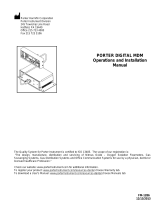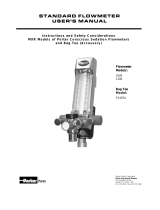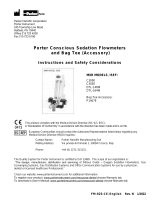Page is loading ...

FM-962 Rev. D 11/21
COMPACT TRIPLE WALL OUTLET STATION MODEL 6255-1
INSTALLATION AND OPERATING INSTRUCTIONS
To assure safe operation and conformation to local
fire codes, all Porter Outlet Stations are designed to
be used with sedation delivery systems mounted
inside walls and they meet or exceed the guidelines
established by the National Fire Protection
Association for Nonflammable Medical Gas Systems,
NFPA 99. Copies of NFPA 99 or portions thereof may
be obtained by writing to:
National Fire Protection Association
Batterymarch Park, Quincy, MA 02269-9904
Or call: 1-800-344-3555
The Porter Compact Triple Wall Outlet Station (6255-
1) provides a quick, safe, and reliable method of
connection to both Porter Sedation and Clean-Air™
outlet service. The 6255-1 provides all the service
features of the Porter 6200-1 N2O/O2 outlet station,
and the Porter 5600-3 Clean-Air outlet station.
Features include the cross+protection system to
prevent unintentional misconnection to the central
piping system. The outlet station utilizes a duplex
connector which prevents the Nitrous Oxide from
being connected unless the Oxygen is connected,
and offers oxygen resuscitator quick connect
compatibility. Compact stainless steel face plate is
color coded for instant gas identification. A qualified
plumber can install the outlet station by following the
details listed in this brochure.
See Page 3 and 6 for Dimensions
STATION INSTALLATION INSTRUCTIONS
1. LOCATION: Select appropriate location for
mounting station to a stud prior to installing
drywall or wall board. Secure bracket (left or
right side) to stud. (Figure 1)
WARNING
Porter, Outlet Stations utilize the cross+protection
system. The copper tubing is diameter indexed; 3/8”
O.D. for Nitrous Oxide and ½” for Oxygen. The
cross+protection system is designed to prevent
misconnection of Oxygen and Nitrous Oxide piping.
DO NOT ATTEMPT TO CHANGE THE
DIAMETERS! Tampering with the cross+protection
system constitutes acceptance of liability by the
installer. For your own protection, as well as that of
the Doctor and the patients, use 3/8” O.D. tubing for
all Nitrous Oxide lines and ½” O.D. tubing for all
Oxygen lines.
Figure 1

2
WARNING
Dental workers are exposed to N2O during
administration of N2O/O2 conscious sedation
analgesia. NIOSH has recommended that exposures
should be minimized. Contact NIOSH (1-800-35-
NIOSH) to receive NIOSH Publications on Control of
Nitrous Oxide in Dental Operatories. Exposure can
be minimized by effective controls. National Institute
for Occupational Safety and Health (NIOSH)
publications state that controls, including System
Maintenance, Ventilation and Work Practices can
effectively reduce N2O concentrations in dental
operations. Your Porter Scavenger System is an
important part of the system of controls.
2. PIPING REQUIREMENTS
2.1. Sedation Outlet Connections (N2O/O2)
This portion of the 6255-1 outlet station has
the option of unscrewing the gas block,
(N2O/O2) (Figure 2) from the support plate
(three screws), inverting the block so the
pipes may extend downward (Figure 3).
2.2. IMPORTANT: When remounting the
blocks to the support plate use the lower set
of holes on the plate (Figure 3) to insure the
faceplate will line up. (Note: This is only
when pipes are pointing down.)
2.3. Pipes can then be joined to their appropriate
3/8” OD tube for Nitrous Oxide, and ½” OD
tube for Oxygen. (See section below.)
2.4. Central Suction Powered Systems:
Determine the direction in which the piping
is needed.
2.5. If the vacuum tube (1/2” OD) is required in
the upward position, be aware that moisture
could drain back into the tubing. It is
recommended that a trap be used.
2.6. If the vacuum tube (1/2” OD) is required in
the downward position, unscrew the vacuum
block from the support pole (two screws),
invert the block (Figure 4) and screw the
vacuum block back onto the support plate.
2.7. IMPORTANT: When remounting the block
to the support plate use the upper set of
holes on the plate. (Note: This is only when
pipe is pointing down.)
Figure 2
Figure 3

3
3. DRYWALL OR WALL BOARD CUT-OUT
AND STATION FIXTURING DETAILS
3.1. Closing up walls requires a 2 1/2” H. x 4 1/2”
L. cut-out opening. See template diagram
for actual cut-out outline on page 6.
3.2. Bracket opposite stud butts up to underside
of drywall.
4. INSTALL THE GAS SUPPLY LINES:
Note: The station is designed and intended to be
used with gas supply lines installed using NFPA
99 guidelines, including a 150 PSI piping integrity
test. Medical grade dry Nitrogen should be used
as a “forming gas” while soldering. To prevent
oxidation inside supply lines:
(a) Use type K or L, pre-cleaned, degreased,
capped copper tubing ONLY.
(b) Use 3/8” O.D. for Nitrous Oxide, use ½” O.D.
for Oxygen. DO NOT CHANGE TUBING
DIAMETERS!!
(c) All copper to copper joints are to be made
using a brazing allow conforming to AWS
Classification BcuP-5 (see AWS Std. A5.8).
Flux shall not be used.
(d) After connecting all gas lines, check the
system for leaks with dry Nitrogen per NFPA
99, by performing a 150 psi, 24 hour piping
integrity test (5 psi drop allowed).
5. Check for Crossed Lines. (Refer to NFPA
Gas and Vacuum Systems Code for Type II
Systems) (See cross+protection Warning in
this brochure.)
AFTER DRY WALL IS INSTALLED
6. Remove cover cap. Check to make sure leading
edge of box is flush with dry wall. If mounting
box is incorrectly aligned, loosen bracket
mounting nuts with a 11/32” open end wrench,
adjust to fit, re-tighten nuts.
IMPORTANT NOTE: If installing with Model
2022 Slide Mount Bracket, set the leading edge
of box out of the drywall to compensate for 2022
plate thickness. (Refer to LB-313)
7. Alignment and Adjustment for Front Plate
Installation – The Oxygen and Nitrous Oxide
Valve Bodies are factory adjusted to allow for the
back of the Front Plate to press against the metal
surfaces of all three valve bodies. If adjustment
is needed, follow these steps:
7.1. Rotate the Oxygen and Nitrous Oxide valve
bodies so they both uniformly contact the
back of the Front Plate. Oxygen has right
hand threads and Nitrous Oxide has left
hand threads.
7.2. Adjust the right hand thread vacuum valve
body to align with the metal surfaces of the
other valve bodies
Figure 4

4
8. Install Front Plate with the six 4-40 flat head
screws.
9. Apply diameter indexed N2O/O2 gas label in
place over diameter indexed check valve
connector bushings. Pull off center strip backing,
and press label in place. Remove top and
bottom backing strips, and finish securing label.
10. Connect an 8060 series duplex connector and
hoses into the completely assembled Triple
Outlet Station. Attach the other end of the hoses
to a flowmeter and turn the flow control knobs to
the off position and the on/off switch to the off
position.
11. Leak test the entire system for working
pressure leaks. Pressurize the sedation gas
supply lines with 50 PSI. Observe any pressure
decay overnight. This 50 PSI test with the
flowmeter tubing connections in place tests the
seal of the duplex connector extended into the o-
rings of the outlet station primary check valves.
(5 PSI drop allowed.)
12. Attach the appropriate vacuum lines from the
rubber goods to the outlet station vacuum source
via the quick connect (5602).
CONNECTIONS TO FLOWMETER –
OPERATING INSTRUCTIONS
Flowmeter Gas Supply Tubing and Vacuum Tubing is
connected to the Triple Outlet Station via two quick
connect couplers. The Porter 8060 series duplex
connector simultaneously connects the Oxygen and
Nitrous oxide tubing, and prevents the Nitrous Oxide
from being connected unless the Oxygen is
connected. The Porter 5602 vacuum quick connect
with hose barb separately inserts into the vacuum
check valve of the station.
QUICK CONNECTING
You may quick connect to the station when the
system pressure is at its normal 50 PSI; the primary
check valves seal this pressure. Both couplers have
locating latches. Simply insert the couplers into the
appropriate check valve and confirm the latch is in
place behind the catch feature of the valve. A gentle
tug on the coupler will confirm a stable latch position.
Internally, within the primary check valve, an o-ring
seals against a poppet. The same o-ring seals
against the quick connect extensions upon insertion.
Slide the latch out of position to remove the
connector and the internal poppet will automatically
move back into its sealing position.
OXYGEN RESUSCITATOR
By removing the duplex connector, an oxygen
resuscitator quick connect may be inserted into the
oxygen station position.
MAINTENANCE AND SERVICE
Use Scavenging
Monitor for N2O in the operatory to insure that
controls are effective in achieving low levels of ppm
(parts per million) exposure. Contact your Porter
dealer for details on monitors and testing.
Inspect and maintain the analgesia delivery
system to prevent N2O leaks in all hoses,
connections and fittings. Repair all leaks
immediately.
Opposite position for 5602 right angle
vacuum quick connect hose barb: Reconfigure
the fitting using the following steps if you need the
barb to point in the opposite direction.
Clip Reversal Instructions:
1. Note orientation of Clip on Assembly: Hold
assembly with Hose Barb in the down position,
and with the smooth post facing you.
1.1. Note the position of the clip on the
assembly. This is important, as you will
need to rotate the clip 180° from its
original position.
2. Remove the Crescent Ring using the blade of a
small flat blade screwdriver.
3. Lift the clip from the assembly, and as you do so,
the spring will fall from the clip.
4. Slide the clip back onto the assembly in a
position 180° from its original location.
5. As the clip is brought down onto the post, place
the spring onto the pin (located on the clip), and
tuck the opposite end into the pocket on the
adapter body.
6. Again using a flat bladed screwdriver, push the
Crescent Ring back into the groove on the post.
Orient the Crescent Ring such that the opening in
the ring faces away from the spring.
7. Actuate clip to ensure proper operation of the
assembly.

5
MONTHLY CHECK
Leak test the entire system for working
pressure leaks. Connect an 8060 series duplex
connector and hoses into the Triple Outlet Station.
Attach the other end of the hoses to a flowmeter and
turn the flow control knobs to the off position and the
on/off switch to the off position.
Pressurize the sedation gas supply lines with 50 PSI.
Observe any pressure decay overnight. This 50 PSI
test with the flowmeter tubing connections in place
tests the seal of the duplex connector extended into
the o-rings of the outlet station primary check valves.
(5 PSI drop allowed.)
SERVICE PRIMARY AND SECONDARY
CHECK VALVE ASSEMBLIES
The Oxygen and Nitrous Oxide primary and
secondary check valve assemblies may be field
disassembled and replaced.
1) Primary Check Valve Assembly O2 A-2689-000
N
2O A-2690-000
2) Cartridge Body O2 B-2237-000
N
2O B-2275-000
3) 016 O’ Ring PB-102-215
4) Secondary Check Valve Assembly A-2699-000
5) Compression Spring PB-115-63SS
PRIMARY CHECK VALVE
DISASSEMBLY INSTRUCTIONS
SERVICE PRIMARY CHECK VALVE
May be serviced with station pressurized to
50 PSI.
1. Remove front plate. Mounting screws are behind
plate labels.
2. Unscrew the primary check valve assembly.
Oxygen right hand threads; Nitrous Oxide left
hand threads.
Note: the secondary check valve will
move into position and seal the 50 PSI of
the station pressure as the primary check
valve assembly is removed.
WARNING
Do not remove the cartridge body while
servicing the primary check valve
assembly. The secondary check valve
cannot seal the 50 PSI pressure if the
cartridge body is removed.
3. Replace the entire assembly.
4. Screw the replaced assembly into the cartridge
body.
5. Alignment & Adjustment for Front Plate
Installation – The Oxygen and Nitrous Oxide
Valve Bodies are factory adjusted to allow for the
back of the Front Plate to press against the metal
surfaces of all three valve bodies. If adjustment
is needed, follow these steps:
5.1. Rotate the Oxygen and Nitrous Oxide valve
bodies so they both uniformly contact the
back of the Front Plate. Oxygen has right
hand threads and Nitrous Oxide has left
hand threads.
5.2. Adjust the right hand thread vacuum valve
body to align with the metal surfaces of the
other valve bodies.
6. Leak test the entire system for working
pressure leaks per the Monthly Check.

6
SECONDARY CHECK VALVE
DISASSEMBLY AND SERVICE INSTRUCTIONS
WARNING
To service the secondary check valve, first turn off pressure. Do not remove the
cartridge body until the pressure is bled off. The secondary check valve cannot
seal the 50 PSI pressure if the cartridge body is removed.
1. Turn off pressure at tanks in tank room.
2. Follow procedure to remove primary check valve assembly.
3. Depress secondary check valve further into station block using a small probe or screw driver to bleed off
pressure.
4. Unscrew cartridge body out of the station block.
5. Take a small screw driver or needle nose pliers and insert into holes at the center of secondary check valve.
Carefully remove check valve and spring.
6. Replace the 016 o-ring and secondary check valve parts as required and place in position for reassembly.
7. Screw in the cartridge body and tighten.
8. Screw in the primary check valve assembly and align and adjust for front plate installation.
9. Leak test the entire system for working pressure leaks per the Monthly Check.
/











